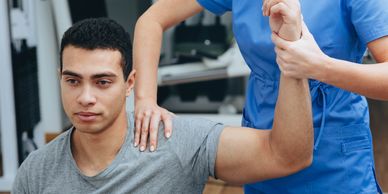Massage Course Descriptions
Anatomy and Physiology
Biomechanics (Kinesiology)
Biomechanics (Kinesiology)

This course provides a comprehensive, evidence based study of the anatomy and physiology of the human body. Topics include body organization; homeostasis; cytology; and the 11 major organ systems with a specific focus on the muscular and skeletal systems. Upon completion, students should be able to demonstrate an in-depth understanding of principles of anatomy and physiology and their interrelationships.
Included in this course is a section called Manikin (20 hours = 4 classes) where students sculpt 13 major muscle groups from clay. This section develops practical understanding of the complexity of muscular origins and insertions and their correlation to how the body moves.
Biomechanics (Kinesiology)
Biomechanics (Kinesiology)
Biomechanics (Kinesiology)

Biomechanics is the study of the structure, function and motion of the mechanical aspects of biological systems. This course focuses on the study of how muscles produce force and move along with the nervous system which controls this process. Key concepts include muscle function, muscle contraction, physiological and environmental factors that affect biomechanics.
Ancillary Therapies
Biomechanics (Kinesiology)
Myofascial Deep Tissue Massage

This course explores a variety of standard modalities that are additional tools in a massage therapy practice. Classes include theory and hands-on practice of the following: aromatherapy, reflexology, Indian head massage, lymphatic drainage, cupping, hot stone, chair massage, body treatments and prenatal.
Myofascial Deep Tissue Massage
Myofascial Deep Tissue Massage

This course highlights the anatomy of fascia and the location of the fascial lines running throughout the body and the therapeutic benefits of myofascial release and additional deep tissue modalities such as trigger point therapy. Students will learn the implementation of these modalities to help free fascial restrictions, increase functional mobility, evaluate and improve postural distortions and breathing capacity in their clients.
Swedish Massage

his course educates students on the modality of Swedish massage through exploration of the various classical strokes to address issues in the superficial tissues of the body. Topics included in this course are professional draping, assessment skills to guide development of a basic treatment plan to meet the needs of a range of clients, and practical application of supportive body mechanics.
Business Practices & State Law

This course contains topics such as business fundamentals, marketing strategies, client management, practice setup, legal and ethical considerations, insurance, pricing structures, financial planning, scheduling systems, professional development, State law governing massage therapists and massage therapy businesses, and compliance with industry regulations. This course is tailored to the specific needs of a massage therapy practice, whether it be in an employment setting or an independent practice. Students will write an informal business plan as a guide for their first year in practice.
Professionalism & Ethics
Hygiene, Sanitation, Sterilization & Safety
Professionalism & Ethics

Topics covered in this course are professional boundaries, informed consent, confidentiality, therapeutic communication, power differentials, sexual misconduct prevention, dual relationships, scope of practice, ethical decision-making, reporting unethical behavior, understanding relevant state regulations, and adherence to professional codes of ethics from organizations like the American Massage Therapy Association (AMTA) and Associated Bodywork and Massage Professionals (ABMP).
Student Dynamics
Hygiene, Sanitation, Sterilization & Safety
Professionalism & Ethics
.jpg/:/cr=t:17.32%25,l:13.24%25,w:73.53%25,h:65.36%25/rs=w:388,h:194,cg:true,m)
Student Dynamics refers to topics beyond academic content, including student and teacher behaviors, emotions, and interactions. This course outlines the expectations for the students’ behavior and academic success as well as what students can expect from the faculty and administration. Through exploring the four major learning styles, students will discover how they learn best individually in order to develop active learning and studying strategies.
Hygiene, Sanitation, Sterilization & Safety
Hygiene, Sanitation, Sterilization & Safety
Hygiene, Sanitation, Sterilization & Safety

This course provides essential knowledge and practical skills in maintaining hygiene and safety in massage practices. Students will learn about universal precautions, proper sanitation techniques, and effective infection control measures to prevent the transmission of infections. Topics include personal and environmental cleanliness, safe handling of equipment, and protocols to ensure a safe, healthy environment for both practitioners and clients. By the end of the course, students will be equipped with the tools to uphold the highest standards of hygiene and safety in their professional practice.
Student Clinic Experience
Student Clinic Experience
Hygiene, Sanitation, Sterilization & Safety

The Student Clinic Experience is the practical component which allows students to apply massage techniques under the close supervision of instructors. This allows them to gain hands-on experience in a real world situation in a controlled environment.
This course includes an introduction to clinic experience, scheduling their clinic hours, the documentation process, exploration of the clinic space, as well as hands-on practice prior to them meeting with clinic clients.
CPR & FIRST AID
Student Clinic Experience
CPR & FIRST AID

Taught by the American Red Cross, this course includes peer-to-peer interactive scenarios to build the skills and confidence to provide this life saving procedure.
Students will receive CPR and First Aid certification so students can provide assistance to someone who is having a cardiac or breathing emergency.
Turn Your Passion into Purpose
Complete Massage Course Descriptions
ATEAM - Massage Course Descriptions (pdf)
Download
classes start 1/5/2026
If you were enrolled in HAC and displaced by the closing, contact us to discuss options for completing your program now.
This website uses cookies.
We use cookies to analyze website traffic and optimize your website experience. By accepting our use of cookies, your data will be aggregated with all other user data.